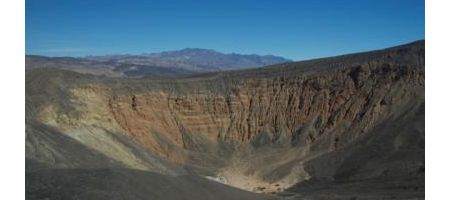Geologists have discovered that Death Valley’s Ubehebe Crater, formed by a volcanic explosion, was created much more recently than thought — and that it could go off again any time.

The half-mile-wide, 600-foot deep crater, was formed when a rising plume of magma hit a pocket of underground water, creating an explosion. But until now, the date was unknown. The most common estimate was about 6,000 years, based partly on Native American artifacts found under debris.
Now, though, a team based at Columbia University’s Lamont-Doherty Earth Observatory has used isotopes in rocks blown out of the crater to show that it formed just 800 years ago, around the year 1200.
That means it probably still has some strength left in it – and, the scientists believe, there’s probably still enough groundwater and magma around for another reaction.
Ubehebe is the largest of a dozen craters, clustered over about three square kilometers of Death Valley National Park, but had been poorly studied until now.
When it exploded, nothing within two miles would have survived, says study coauthor Brent Goehring, now at Purdue University. “It would be fun to witness — but I’d want to be 10 miles away,” he says.
The eruption dates revealed by the isotopes clustered from 2,100 to 800 years ago. The team beleives this indicates a series of smaller explosions, culminating in the big one that created the main crater around 1200.
As a result, says Lamont-Doherty professor Nicholas Christie-Blick, magma is probably still lurking somewhere below – and other researchers have spotted what look like magma bodies under other parts of Death Valley.
“Additional small bodies may exist in the region, even if they are sufficiently small not to show up geophysically,” he says. He adds that the dates indicate an eruption frequency of about every thousand years or less, which puts the current day within the realm of possibility.
“There is no basis for thinking that Ubehebe is done,” he says.
Any eruption would almost certainly be preceded by warning signs such as shallow earthquakes and opening of steam vents, giving several years’ warning, so park officials aren’t worried.
“We’ve typically viewed Ubehebe as a static feature, but of course we’re aware it could come back. This certainly adds another dimension to what we tell the public,” says geologist Stephanie Kyriazis, a park education specialist.
“Right now, we’re not planning to issue an orange alert or anything like that.”






